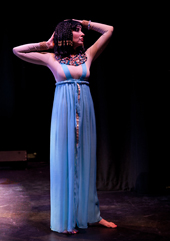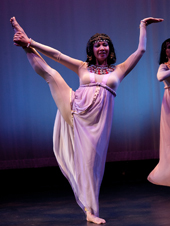 |
The Boating Party (2008) 8 minutes • Ancient Egyptian Dance • Adapted and directed by Morgiana Celeste Varricchio Ancient Egypt has left a rich artistic and textual legacy. Yet, references about dance and dancers in literature and administrative documents are casual, and very little is known about the dance in remote antiquity. Representations of dancers in ancient Egyptian wall paintings and reliefs, painted pottery and statuettes give a visual reference. However, Egyptian artists were bound by strict conventions: for the most part, the human figure was depicted two-dimensionally, thus the reconstruction of ancient Egyptian dance and movement faces many obstacles. Nevertheless, by utilizing all of the evidence, it is possible to learn something about ancient Egyptian dance and to determine the nature of the images depicted in art. Taken together with descriptions of dances by ancient historians, and the instrumentation used in the accompaniment of the dance, it is possible to make a somewhat feasible, if not completely accurate re-construction. The Boating Party is a “tale of wonder,” written on papyrus over 3,000 years ago. The story is communicated here through movement which imitates postures and gestures seen in Egyptian art and hieroglyphic writing, combined with movement based upon the structure of dance universally. Some of the steps are still used in contemporary Egyptian dance, and as a theater piece, artistic license has been taken by the choreographer. — Phaedra |
|
||||
|---|---|---|---|---|---|---|
|
||||||
|
||||||
|
||||||
|
||||||
|
||||||
| ||||||

